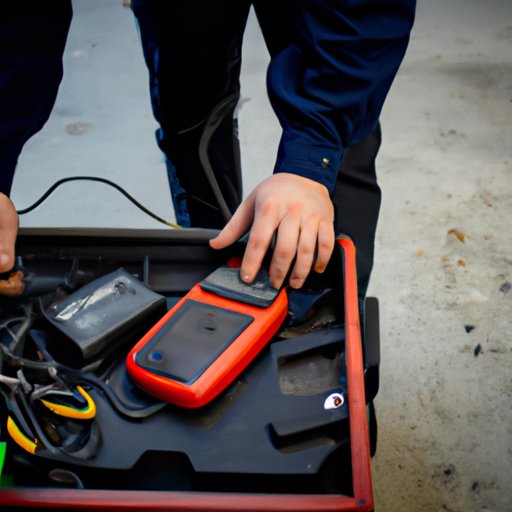Introduction
A remote starter is a device that allows you to start your car from a distance. It’s a convenient way to warm up or cool down your car before you get in it. Remote starters are becoming increasingly popular, as they offer convenience and comfort without sacrificing safety.
Definition of Remote Starters
Remote starters are electronic devices that allow you to start your car from a distance. They can be controlled with either a key fob or an app on your phone. The remote starter will then send a signal to the car’s ignition system, which will turn the engine on. Depending on the type of remote starter you have, you may also be able to remotely lock and unlock your doors, pop the trunk, and control other features of your car.

Benefits of Having a Remote Starter
Having a remote starter can provide several advantages. It can save you time and energy by allowing you to start your car without having to leave the house. It can also make your car more comfortable when you do get in, since it will already be at the right temperature. Additionally, some remote starters come with additional security features that can help protect your vehicle.
Types of Remote Starters
There are several different types of remote starters available on the market, each with its own set of benefits and drawbacks. Here’s a quick overview of the most common types:
- Key Fob Remote Starters: Key fob remote starters are the most basic type of remote starters. They are typically the least expensive option and are easy to install. However, they don’t offer many features beyond starting your car.
- Smartphone Remote Starters: Smartphone remote starters allow you to control your car from your phone. They typically offer more features than key fob remote starters, such as locking and unlocking your doors, popping the trunk, and controlling other features of your car. However, they often require a subscription and can be more expensive.
- Two-Way Remote Starters: Two-way remote starters are the most advanced type of remote starters. They allow you to start your car from a distance and receive a confirmation that the car has been started. They also usually offer additional features, such as temperature control and security alerts. However, they are typically the most expensive type of remote starter.
Installation Process
Installing a remote starter requires some technical know-how and can be a complicated process. Before you begin, you should make sure you have all the parts and tools you need, including the remote starter unit, wiring harness, and any necessary hardware. You may also want to consult the instructions that come with your remote starter for specific instructions.
Step-by-Step Guide
Once you’ve gathered all the necessary parts, you can begin the installation process. Here’s a step-by-step guide to help you get started:
- Disconnect the negative terminal of your car’s battery.
- Mount the remote starter unit in a secure location.
- Connect the wiring harness to the remote starter unit.
- Connect the wiring harness to the car’s electrical system.
- Reconnect the negative terminal of your car’s battery.
- Test the remote starter by pressing the remote start button.
Tips and Tricks
When installing a remote starter, it’s important to take your time and follow the instructions closely. Here are a few tips to keep in mind:
- Make sure to disconnect the negative terminal of your car’s battery before beginning the installation.
- Read the instructions carefully and follow them step-by-step.
- Check all connections to make sure they are secure.
- Test the remote starter after you’ve finished the installation.
Programming a Remote Starter
Once you’ve installed the remote starter, you’ll need to program it to work with your car. This process varies depending on the type of remote starter you have, but it generally involves connecting the unit to your vehicle and following the instructions provided by the manufacturer. If you’re having trouble programming your remote starter, you may want to contact the manufacturer for assistance.
Safety Considerations
Remote starters can be dangerous if used improperly. It’s important to understand the safety features and operating instructions of your remote starter so you can use it safely. Here are a few safety tips to keep in mind:
- Never leave children or pets unattended in a car with a remote starter.
- Always check the area around your car before remotely starting it.
- Don’t use the remote starter if there is any flammable material near the car.
- Make sure to read the instructions that come with your remote starter.
Demonstrating How to Use a Remote Starter
Using a remote starter is relatively simple. Here’s a step-by-step guide to help you get started:
- Press the lock button on your remote starter to lock the doors.
- Press the remote start button on your remote starter.
- Wait for the car to start.
- Unlock the doors with the remote starter.
- Get in the car and drive away.
Troubleshooting Common Issues
If you’re having trouble with your remote starter, there are a few things you can try. Here are some common issues and potential solutions:
- The remote starter won’t start the car: Make sure the battery is charged and that all connections are secure. You may need to reprogram the remote starter or replace the battery.
- The remote starter won’t stop the car: Check to make sure the remote starter is connected to your car’s electrical system. You may need to reprogram the remote starter or replace the wiring harness.
- The remote starter won’t lock or unlock the doors: Make sure the remote starter is connected to your car’s electrical system. You may need to reprogram the remote starter or replace the wiring harness.
Conclusion
A remote starter can be a great way to make your life a little bit easier. By understanding the different types of remote starters, the installation process, programming, and safety considerations, you can ensure that you get the most out of your remote starter. With patience and careful attention to detail, you can have your remote starter up and running in no time.
(Note: Is this article not meeting your expectations? Do you have knowledge or insights to share? Unlock new opportunities and expand your reach by joining our authors team. Click Registration to join us and share your expertise with our readers.)
